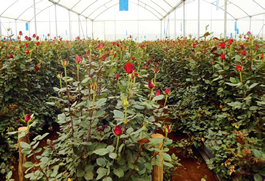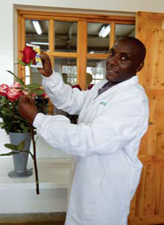Mt. Kenya region is extremely scenic with the escarpment giving way to dramatic wooded gorges and tangled riverine thickets. Behind the scenery flower farming is a big business. Maurice Koome Writes.
 Due to the diverse range of habitats, Laikipia hosts an abundance of wildlife, second only to the Masai Mara in Kenya. It has significant populations of predators and also the “big five”, with over 50% of Kenya’s Black and White Rhinos, thousands of elephants, about 25% of the world’s Grevy Zebras, and an increasing population of Wild Dogs. The focus of wildlife viewing here is in Lewa Wildlife Conservancy.
Due to the diverse range of habitats, Laikipia hosts an abundance of wildlife, second only to the Masai Mara in Kenya. It has significant populations of predators and also the “big five”, with over 50% of Kenya’s Black and White Rhinos, thousands of elephants, about 25% of the world’s Grevy Zebras, and an increasing population of Wild Dogs. The focus of wildlife viewing here is in Lewa Wildlife Conservancy.
More than great Scenery
When I first met Mr. Kanyingi, Editor Floriculture Magazine in one of our product launches at a Nanyuki Hotel, he was full of lamentations. “Mt. Kenya is more than Snowy Mountain”, I answered. “Yes I know, it is the most accessible, and popular with Johnnies. The Timau and Nanyuki triangle is characterised by diverse landscapes, rolling hills interrupted by rocky outcrops intricately merged into beautiful scenery reminiscent of a canvas painting.
The rocky outcrops culminate into Mt Kenya, an extinct volcano, home to point Batian, the second highest peak in Africa. Mt Kenya is undisputedly the most dominant and the most beautiful feature in the region. It draws lots of visitors from all over the world, adventurous travellers with intentions of scaling its heights or hiking in the moor lands and religious zealots who come to pray within its serene grounds.
Much of Timau all the way to the Nanyuki is intensively cultivated undulating plains. Wheat farms cover as much as the eyes can see. Equally fascinating are what appear to be lakes or ponds from afar. These are green houses for flower and horticulture farming. Flowers and horticulture produce from these farms are for export market. Also noticeable are huge flocks of sheep and herds daily cows,” he concluded. “It is more than what you are calling lakes or ponds a far, flower farming is a big business,” I told him.
One by One
In conclusion of our discussion Kanyingi challenged me for a ride round the farm to file a good article on flower farming in Mt. Kenya.
The capital city of Kenya is Nairobi, meaning a place of sweet waters; therefore it would be appropriate that we begin the journey to visit all flower farms in Mt. Kenya at the fresh water spring of KISIMA, it was very sweet. This was the start of the long journey down the mountain.
We went down the road to UHURU, where We found total freedom which reminded him of 1963, the year Kenya attained its independence. A stone throw something was blooming, I told him it was BLOOMING OASIS. He was in love with a fresh upcoming greenhouses just adjacent and behind AAA CHUI FARM but the leopard could not feast on it. That is PENDEKERZA the third born of TAMBUZI. We discovered PJ DAVE and TAMALU on our way for a cup of tea at SUNLAND TIMAFLAIR who introduced us to their sibling, SUNLAND PROTEA. In between was FINLAY-SIRAJ whose beauty was amazing.
After a short break with no problem of course, we headed for BATIAN that was on the slopes of the mountain where we also spotted TIMAFLOR and LOLOMARIK. A quick drive took us to FINLAYS-IBIS, GREENLANDS and EVEREST.
First on our way down was KONGONI, which were close to LIKI RIVER and if one went close by TURACO farm you could see EQUINOX. Long way ahead of us was COUNTRYWIDE CONNECTIONS. I thought we saw something that looked like half goat until we realized it was TAMBUZI. In the far distance was MWEIGA BLOOMS with a long meandering road all the way to T. Falls.

Fastest Growing
By the count, we had no less than 484 hactares and this prompted him to ask a few growers for an evening drink at Kongoni. Believe it or not, he agreed Mt. Kenya region is the fastest floricultural growing region one of the country. The nature of the ornamental projects varies from new projects to expansions of the old farms. Some of the new farms have already been established in other regions of Kenya.
Why Mt. Kenya?
The crown jewel of Kenya’s flower growing was Naivasha, then came Athi River, Nakuru and Eldoret. Suddenly all eyes turned on Mt. Kenya which despite been older than the last, it was the pigmy of Kenya’s floriculture sector. Little did speculators know, Mt. Kenya was a sleeping lion and sooner or later, the claws will be out. For long, any discussion on flower growing in Mt. Kenya centred on Mweiga, Batian and Timaflor. The rest as they say is history.
Today, Mt. Kenya is the third largest growing area after Naivasha and Nakuru. Most of the indigenous farms are expanding wholesomely.
Big Head Long Stems
While intermediate roses are the majority in Kenyan production, T-hybrids roses are on the rise especially on altitudes of 2,200 metres or higher where the climate is suitable for these varieties. Most expansions of greenhouses is taking place on the higher altitude, Mt. Kenya became a definite choice. Growers are now moving to quality big headed and long stemmed flowers. It does not need a rocket scientist to know that, you can only achieve these in Mt. Kenya, which is 2200 metres compared to Naivasha’s 1800 metres.
Availability of Land, Water and Labour
The limits regarding the expansion of the production are vast. Unlike Naivasha, Mt. Kenya is not crowded and investors can easily acquire hectares of land. Additionally, the labour force is easily available. In theory, it is easier to get more workers from the rural expansions and avoid unnecessary housing of workers.
This ensures growers will not perturb the existing ecosystems. There is no need of transporting workforce as the area has a stronger workforce. One should employ from the community where the farm is situated. Water is also readily available with some getting it from rivers around, sinking bores which provide a lot of water. Collecting/ tapping rain water and storing in dams is also a major source.
Cordial relationship with the surrounding communities
Regarding the people who live around the farm, Harry of Equinox says, “Our aim is to be beneficial to them, we don’t want to be predominant or disturb their social lives.” Unlike other areas, they do not need to fight for the minimal resources available. “We have plenty of water,” he adds. In addition, most farms repair the feeder roads in the area; provide learning materials, health care facilities, clean drinking water, tree seedlings etc. This has ensured their cordial relationship with the community.
Taking care of environment
Besides the communities, most farms don’t want their farms to be a concern factor for the environment. Keeping the high trees around the fields and greenhouses is one visible way of putting this into practice
“Eventually we want to become carbon dioxide neutral, in which we also include the emission from the airfreight, says Mr. Attanus Mutiso of Kisima Farm. For this reason, we have not disturbed the high natural trees surrounding the farm, “We are also looking at planting more trees”, he adds.
No Spilling of waste
Also for the sake of environment most companies have series of ponds dug in the middle of the farms. “These wetlands are for cleaning waste water from the pack house and the canteen in a natural way,” Mr. Mutiso explains. “The process takes about 30 days after which the water flows into the reservoir, and later used for irrigation in the greenhouses,” he adds.
To communicate all these measures regarding social and environmental standards and also remain self critical, Mr. Mutiso points at a number of standard certification most companies have achieved both locally and internationally.
Co-odination Between Investors
Flower growers in this region are well coordinated to an extent of forming a group called Mt.kenya flower growers. This helps them face/ solve problems together through knowledge sharing. They also handle issues of CSR and security together. In addition, they have a strong bargaining power which has made most suppliers start seminars and trainings in the area.
CHALLENGES
Consistency of trained labour
As discussed earlier labour is readily available, however because people are doing other types of farming maintaining/ retaining them is difficult, So one will keep on training the workers who keep on moving when its season for those other subsistence crops.
Flower transportation
This is a problem right from the green houses to the grading sections when it’s raining, also poor infrastructure can cause transportation from the farm difficult in some weathers. Proximity to the airport is also a major problem from the area.
Diseases
This area due to its climatic conditions experience a lot of diseases compared to area in low altitude. This raises the cost of production and to some who don’t follow best protection measures loose production/crop.
Conclusion
With the special approach towards farming, where efficiency, reducing costs or increasing returns seem to be on the top of the target list for investors, there is one big question remaining. Will Mt. Kenya continue to be the choice of investment for most flower growers?
“Yes”, says Mr. Kruger the General Manager, Equinox. “Otherwise, the influx would have stopped already. We are providing the best business atmosphere for flower growers. The costs are very low, we have plenty of resources, there is labour availability and the infrastructure is improving. Moreover, the quality is the best. This obviously influences the profits. Getting the highest profit and enjoying what they do, is the goal of every investor, what will stop them from Mt. Kenya?” he asks.
Maurice Koome is the Bayer
Cropscience Floriculture Technical
Sales Representative Mt. Kenya region.
